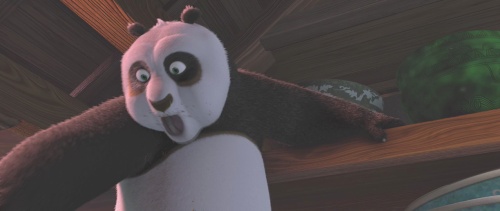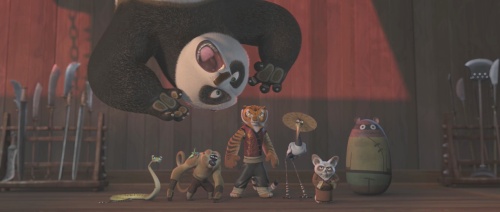Kung Fu Panda (Mark Osborne & John Stevenson, 2008)
Sometimes a title is its own review. Certainly Kung Fu Panda is about what you’d expect. There’s a panda. He likes kung fu. Everyone doubts the panda can do kung fu. The panda triumphs by doing kung fu. And at the end, they play “kung fu fighting” over pictures of pandas. So if you like kung fu, and like pandas, there’s a fair bit going on here for you.

I know I turn every review of an animated film into a meditation on the current state of the animation industry. Sorry. And I don’t like to write jaded-sounding, bored reviews of films either – I’ve had a go at critics who get into that frame of mind elsewhere, so there’s no excuse for it. It would be an act of critical tone-deafness to lump this in with all the other computer animated features and say that they’re all the same; they’re not, and Kung Fu Panda is somewhere at the better edge of the mediocre bulge in the middle of the bell curve. But with all those disclaimers made, the problems it does have are shared by many of its contemporaries, and it is worth noting some of these recurring problems, as they seem to have become entrenched problems in the Hollywood model of animated feature-making.
Lack of Aesthetic Unity
Studio animated films have a tradition of being created collaboratively, even more so than in live-action films; stories are mapped out with both scripts and storyboards, and there are usually multiple contributors. This can work, but usually it requires a really sound creative personality at the helm, to pull that team towards a strong and unified vision: this is the kind of role that Walt Disney fulfilled in the early Disney features, or John Lasseter on the early Pixars, or Brad Bird on his films.
Without such a strong gatekeeper vetting what goes into the movie, the jumble of ideas from different contributors leads to a whole lot of discordant notes. Dramatic moments clash with comedy relief. Moments where you are asked to care for the characters are juxtaposed with self-reflexive kidding about the artifice of the movie. And so on. This jangle of tones is in evidence throughout Kung Fu Panda, which goes from ironic comedy to queasy attempts at heartfelt sincerity with disconcerting swiftness.
It is also constantly fighting its own appearance: someone has gone to a lot of trouble to give the film an orientally-influenced look, and there are moments of considerable visual beauty; but the script is built largely around low comedy gags. There’s nothing wrong with a gag-fest (after all, I liked the loopy Emperor’s New Groove, which Kung Fu Panda occasionally resembles). But in live-action films, people have the sense not to shoot Dumb and Dumber as they would The Last Emperor; animated filmmakers need to learn to get their subject and visuals working in harmony.
Weak Story and Reactive Heroes
Perhaps it’s the emphasis on story-boarding, which I can see might encourage a focus on the micro-scale details of the script rather than the macro-scale sweep, but animated films often show a poor grasp of overall story-structure. There is a tendency to for the films to be a string of bravura sequences that have been painstakingly worked out, linked together in ramshackle ways. And because the sequences matter more than the overall plot, the hero starts to seem a passenger in their own narrative. Again, you can see this kind of problem pop up throughout the history of the medium, even in strong films: the Disney classics are full of weak heroes, and Pinocchio is very episodic. If the film isn’t as strong as that – and needless to say Kung Fu Panda is not Pinocchio – such an episodic construction becomes a liability very quickly.
Kung Fu Panda has two really impressive sequences that seem to almost stand-alone, with the story shaped around them: one is an escape from a prison, and one is a fight on a bridge. Our nominal hero, Po the kung fu panda, takes no part in either. In fact, the villainous Tai Lung should be the hero: it is he who overcomes incredible adversity and embarks on an epic quest against overwhelming odds (something about which even one of the film’s screenwriters has complained). The hero and his supporters are largely reactive, simply waiting in one spot for the villain to appear, and there is little attempt to establish why the objectives of either hero or villain should matter to anybody.
Poor Animation
Kung Fu Panda is by no means the worst offender in this regard, but still, there’s a lot of weak animation here, particularly in the supporting characters. This doesn’t get noted enough, because too many critics simply don’t bother to look at the “performances” in an animated movie, or mistake flashy surfaces and special effects for great animation. Remember all those people who talked up the quality of the animation in Happy Feet? Well, those people were wrong and their opinions were worthless.
Outside of the Pixar features, the standard of animation in computer-animated features remains deplorable, and critics need to start pointing this out. There’s some attractive hand-drawn animation by James Baxter at the start of Kung Fu Panda which – though too brief and broad to allow for any real performances – serves as a reminder of how a generation of really good traditional animators has been left with almost no outlet for their work by the switch to computer animation. The computer animation, however, generally remains only so-so.
Strange Subject Choices
Martial arts movies are about seeing great physical feats performed. As I noted when I reviewed Kung Fu Hustle, faking those feats largely defeats the point. So a martial arts extravaganza strikes me as a dubious subject for animation. Animated films need a stronger reason to exist than just “hey, you know two things that people like? Pandas and kung fu!”
Weird Vocal Casting
Firstly, there’s the celebrity problem: financiers can’t resist the lure of stars, although I would have thought their drawing power for this kind of movie is pretty minimal. So here we get a completely inexpressive performance from Angelina Jolie, an actress who I don’t recall ever being noted for her vocal skills.
Even when we move further down the supporting cast list, however, there are strange choices. David Cross, for example, was hilarious in Arrested Development and does at least (unlike Jolie) have a funny voice. But why would anyone cast him as a martial arts master? At the same time, Jackie Chan has an obvious link to martial arts, but everyone knows his vocal delivery isn’t the best, particularly in English. Feature animators (and their studio bosses) should learn the lessons of television animation and use specialist vocal talent to deliver performances actually tailored to their roles.
Given they have been ghetto-ised as “kid’ films,” animated features are particularly vulnerable to the peddling of really idiotic messages. Kung Fu Panda’s “believe in yourself” message is seemingly harmless, but is fatally corrupted by the hero’s unworthiness. Po is an untalented slacker whose limited efforts at self betterment are disproportionately rewarded, while vastly more talented and dedicated people are passed over in his favour. (I know I quibbled with the elitist thematics of Brad Bird’s Incredibles and Ratatouille, but their outlook was vastly preferable to the unthinking populism on display here). Even late in the film, when the hero has his big moment of self-betterment, what he learns is that he doesn’t actually need to learn anything else. That’s the real lesson of Kung Fu Panda: no matter how lazy and untalented you are, a movie will come along to tell you it doesn’t matter how lazy and untalented you are.
